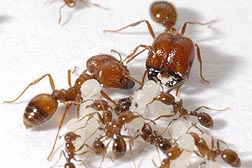| Read the magazine story to find out more. |
|
|
|
|
Tropical Fire Ant Movement Traced to Spanish Ships
By Sandra Avant
December 3, 2015
A genetic investigation of tropical fire ants has revealed insights into the history of their movement across the globe and voyage to America, according to collaborative research between the U.S. Department of Agriculture (USDA) and university scientists.
Researchers, which included scientists at the Agricultural Research Service's (ARS) Center for Medical, Agricultural, and Veterinary Entomology (CMAVE) in Gainesville, Florida, retraced the history of the tropical fire ant using genetic markers. CMAVE entomologist Dewayne Shoemaker, along with colleagues at the University of Vermont and the University of Illinois, analyzed the genetic diversity in the genomes of tropical fire ants, which are natives of Central and South America. They also studied trading patterns of Spanish vessels that sailed to various lands in the 16th century.
Findings from the study, published in Molecular Ecology in 2015, showed that tropical fire ants were likely transported in dirt used to stabilize Spanish ships that sailed from Acapulco, Mexico, across the Pacific Ocean to the Philippines and to other parts of the world. Ants, as well as other invasive organisms, made their way onto land when the dirt from these ships was dumped at different ports to make room for cargo.
Today, the tropical fire ant has spread to nearly all tropical regions. Learning more about invasive organisms such as tropical fire ants is important in finding the best natural enemies to fight them, according to Shoemaker. Also, knowing how ants moved from place to place in the past can help develop methods to prevent future invasions.
In previous research, Shoemaker also reconstructed the invasion history of a different fire ant species, the red imported fire ant. The more researchers learn about invasive ant species, the closer they get to solving problems that infestations can cause, including billions of dollars spent in control, medical treatment and damage repair in urban, agricultural, wildlife, recreational and industrial areas.
ARS is USDA's principal intramural scientific research agency.
Read more about this work in the December 2015 issue of AgResearch.

